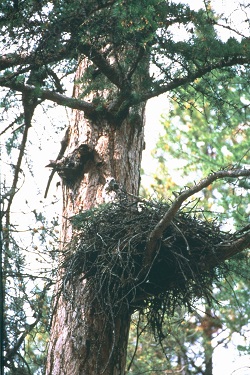Protecting Habitat
Our operational plans contain conservation measures to protect habitat for species of management concern (which include species at risk as well as those of high concern to the public such as moose, marten, and mule deer), and we monitor general trends in habitat types, elements and patterns.
Canfor has identified eight species occurring in our operating areas in BC and Alberta that are red-listed by the International Union for Conservation of Nature and which may be impacted by forestry. The suckley cuckoo bumblebee is classified as ‘critically endangered’; whitebark pine is ‘endangered’; rusty blackbird, western bumblebee, mountain lady’s slipper and sparrow’s-egg lady’s-slipper are ‘vulnerable’, and olive-sided flycatcher and western white pine are ‘near-threatened’ and the western toad has been classified as ‘least concern’.
There are 22 species listed under Canada’s Species at Risk Act occurring within our operating areas that may be impacted by forestry, including the western screech owl, Williamson’s sapsucker, American badger, whitebark pine and Rocky Mountain tailed frog. We use special management practices and monitoring to meet the habitat requirements of species at risk in our operating areas.
The northern goshawk is a large forest raptor that nests primarily in mature and old-growth forests. Northern goshawks prefer large patches of contiguous forest, and are highly sensitive to disturbance during their breeding season. For over 10 years, Canfor’s Senior Forest Scientist Kari Stuart-Smith conducted research into the impacts of forestry on occupancy of northern goshawk breeding areas in the East Kootenay region. Results were used in combination with those from the Skeena region to develop a provincial Best Management Practices (BMP) document, released in 2012. The East Kootenay area has been managing to these BMP unless there are over-riding concerns such as forest health. In 2016, we visited 15 sites with stick nests, and developed management strategies for the seven that were actively used by northern goshawks (the others were red-tailed hawk nests). Five sites require further investigation and will be visited in spring 2017.
 An active goshawk nest (note chick in front of tree).
An active goshawk nest (note chick in front of tree).
Our Houston division in north central BC has been looking for 100-hectare areas where we can overlap old growth management and goshawk nesting sites and has trained Canfor field staff and consultants to recognize goshawks. When our Mackenzie operations found a nest during harvesting in 2015, work was stopped, we increased the reserve area and activities were delayed until after the breeding season.
We worked jointly with the Ktunaxa Nation and its four Bands to identify cultural and conservation value forests (CCVF), which are areas with cultural and/or spiritual significance. Forestry staff and members of the Tobacco Plains Band near Grassmere, Aq’am Band near Cranbrook, Lower Kootenay Band near Creston and Akisq’nuk First Nation near Windermere partnered to identify the CCVF and develop joint management strategies to protect and maintain the values. A process is underway to update the CCVF in a joint project with the Ktunaxa Nation, BC Timber Sales and Canfor.